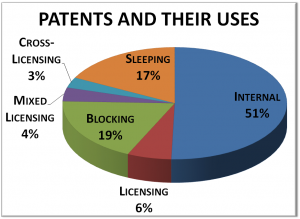General Principle II – Patent Use is Key to Value
By: Fernando Torres, MScIn our intellectual property valuation practice, we are often asked by patentees how they can get a proverbial back-of-the-envelope assessment of the value of their patents.
What at first blush sounds like a reasonable request, its proper answer is not as easy as most would like to think. In this continuing series of blog posts, I will strive to address the question from a practical perspective. In the end, I believe we shall see that not only is there no simple answer, but the question might not be the right one to begin with.
General Principle No. 2
"A patent's use is a key arbiter of its economic value"
Patents can have several uses in practice, and each alternative brings characteristics and contextual parameters that affect economic value in specific ways.
Once a patent holder is in possession of an issued patent it can be put to economic use in at least one of the following ways:
-
INTERNAL – The patent holder may make use of the patent internally in an existing business (or firm). The patent may cover a specific aspect or an improvement of the manufacturing process use in the firm, or it might cover a specific feature of a product. In addition, the patent could be a method patent and claim a specific mode of operating the business, or implementing a procedure in software for example. Internal users typically supplement new patents with existing resources, trade secrets, and knowledge assets to put them in practical use. For example, Apple, Inc regularly obtains patents on its own future product designs or for product features that it plans to incorporate into its products [See e.g. the Patently Apple Blog].
-
LICENSING – The patent holder may focus on licensing the patent to third parties, with the goal of developing a royalty income stream by relying on the licensees to bring together any additional resources to practice the claimed invention. IBM has been granted more patents than any other US company during each year since 1993 [IBM Patent Licensing]. It maintains a broad portfolio of patents in the computer industry specializing in the areas of display, storage, network computing and software. Yet, IBM does not manufacture p0roducts in these areas anymore; it licenses its technologies to third parties that do engage in manufacturing. One technique increasingly used to establish a licensing program has been the threat of litigation. This strategy has been the choice for companies described as "non-practicing entities" or, less charitably, as "patent trolls."
-
BLOCKING – The patent holder might not use the process, manufacture a product, or license third parties, but rather hold on to it in order to block competitors from developing specific products or benefiting from some innovations. This use is typically not publicized for obvious reasons, but imagine a car manufacturer had been the first to patent fuel injectors but did not use them in their vehicles nor licensed them. The competition would have to continue using carburetor-based engines as long as the threat of patent infringement was perceived as real, and the patent folding car company could buy a head start in developing a better fuel injection system for the future, thus staying two-steps away from the competition.
-
MIXED LICENSING – A patentee could have a patent on, for example, a way of compressing and decompressing video to facilitate its transmission over the Internet. The main way in which it can profit from this is if the whole industry uses it and, specifically, if it licenses everyone to use it (even at very low royalties) along with its own internal use.
-
CROSS-LICENSING – In many industries that are host to active patenting, such as telecommunications or pharmaceutical research, patent holders often use patents as bartering pieces to cancel out the threat of infringement litigation form competitors, by licensing some of their patents to the holders of patents it needs to compete, or is likely to be found infringing. A case in point is a recent agreement [Cross-Licensing Report] whereby Intel Corp. (the company famous for its microprocessors) received a license to Nvidia Corp.'s patents, while Nvidia (the company famous for its graphics processors) got a license to some of Intel's patents, thus resolving outstanding litigation between them. As part of the deal, Intel will pay Nvidia $1.5 Billion in royalties over the next five years.
-
SLEEPING or SUBMARINE PATENTS – Sometimes, patent holders do not apply, license, cross license, or litigate their patents; they lie in wait until a suitable target appears, or they are simply shelved (sometimes forgotten) as a consequence of an overly active patenting drive or bad management.
How the actual pool of patents is divided among these uses is hard to ascertain. Nevertheless, relatively recent survey data from the European Commission indicates that the most frequent use is Internal, at 51%, followed by blocking, at 19% (See Chart below) [
2005 Patent Study Report].
From the same European source, we have found that the distribution of the value of patents differs for its different uses (See next Chart). Relative to the value of the average patent surveyed, the most valuable uses by far are, not surprisingly, internal use and cross-licensing. Both of these uses allow patent holders to opewrate in a more profitable protected environment. Blocking, while popular and profitable, is a slightly inferior use of a patent because, one may expect, competitors invest in non-infringing alternatives and defeat the purpose of blocking. The other licensing uses are naturally less valuable than average because licensing involves sharing a portion of the incremental profits with the licensees.
It is no surpise, finally, that Sleeping patents are the least valuable.
In conclusion, from the perspective explored in this post, a follow-up question to correctly approach the valuation of new patent would be simliar to: What is the intended strategic use of the patent?



